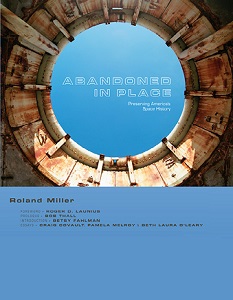The main title of this book, according to the blurb, comes from a phrase stencilled on structures at deactivated facilities at Cape Canaveral Air Force Station that were “too solid for any known method of demolition”.
The argument is that the concrete sections at least were built to withstand rocket launches and rocket explosions and would therefore be difficult to remove with standard equipment; of course most of the metal gantries on the Cape were removed years ago. The author – an academic in Fine Arts – says that about half of the places documented in this photographic history no longer exist and he sees the book as “preserving an important period in history”.
A consultation with an environmental engineer at the Cape on disposing of old photographic chemicals set Miller on a pilgrimage to photograph what he calls “these ruins of early spaceflight” all over the United States. The book is the culmination of this 25-year project. Four authors contribute essays – a historian, a journalist, an astronaut and an archaeologist – which add fascinating perspectives to Miller’s text and images. The book is printed in colour on high-quality paper and has a useful index.
Full disclosure: as a part-time space historian and photographer, I liked this book even before I opened it. That said, this well-produced volume will appeal on a variety of levels to a broad spectrum of readers from those interested in space technology, in particular its history, to those who will view it purely as a photographic art book.
Art, itself, has a very broad remit but the appreciation of the artistic merits of technology is lacking. This book is, in effect, a crossover between space technology and the genre of urban exploration, which produces images of derelict factories and decaying cinemas. It shows that rocket test stands, gantries and blockhouses are at least the equal of those deteriorating gas stations on Historic Route 66.
The book includes shots of launch pads and wind tunnels alongside details of concrete blockhouse domes and rusting flame deflectors. Fans of the Saturn V will find the double-page spread of red-painted umbilical tower segments, still complete with lift shafts and stairways, as poignant as any ‘aircraft graveyard’.
Miller concludes his account with a story of his visit to Complex 34 (the site of the Apollo 1 fire) during a fierce lightning storm. “The storm, the history, the accomplishments, the tragic loss overwhelmed my senses”, he says. “On that day, I let my emotions overtake my purpose. I may not have made any good photographs but I felt the power of the place”. As this book illustrates, you can take the rockets away from these places, but that feeling of power remains.
Mark Williamson











